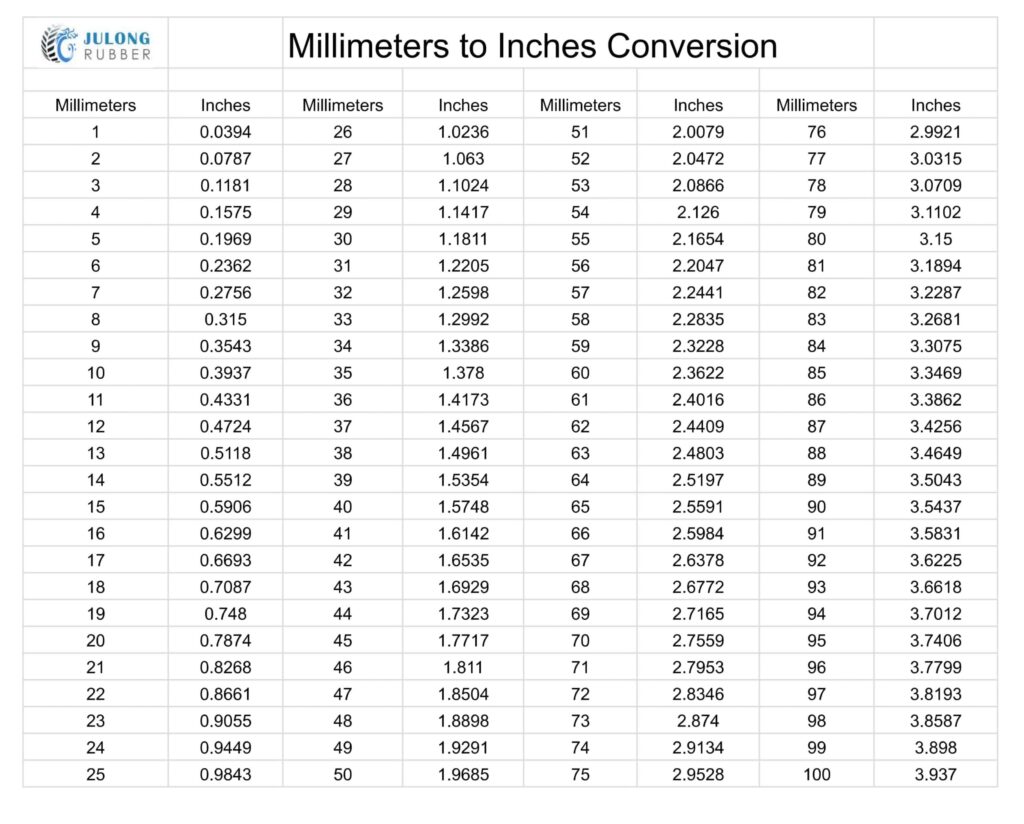In the industrial sector, precise measurements are crucial for ensuring quality and performance across various applications, especially when dealing with components like rubber seals and gaskets. This article delves into the conversion of millimeters (mm) to inches, a common requirement in engineering and manufacturing contexts. We will explore specific examples, such as converting 256 mm to inches and 180 mm to inches while integrating relevant industry keywords to enhance SEO performance.

Why Convert mm to Inches?
Understanding the difference between metric and imperial units is vital for engineers and procurement specialists. The metric system, measured in millimeters, is widely used in manufacturing, while inches are prevalent in various industrial applications, especially in the United States. Misinterpretations in size can lead to fitting issues, production delays, and increased costs.
Conversion Basics
The formula to convert millimeters to inches is straightforward:
1 inch equals 25.4 millimeters.
This means that to convert millimeters to inches, you simply divide the millimeter value by 25.4.
Inches=Millimeters÷25.4
Example Conversions
256 mm to Inches
To convert 256 mm to inches:
256÷25.4≈10.0787 inches
This conversion is crucial for selecting rubber seals that must fit precisely into machined components. Using a seal that is not the correct size can lead to leaks or failures, impacting the overall system performance.
180 mm to Inches
For 180 mm:
180÷25.4≈7.0866 inches
When dealing with industrial rubber seals, understanding this conversion helps ensure compatibility with existing systems, especially when sourcing parts from different countries where metric measurements may be the standard.
Here’s a table that converts millimeters to inches from 1 mm to 100 mm for your review:

Importance of Accurate Measurements in Industrial Applications
In industries such as automotive, aerospace, and manufacturing, accurate measurements are vital for several reasons:
- Sealing Integrity: Rubber seals must fit precisely to prevent leaks in critical systems. For instance, E-shape rubber seals are designed for optimal sealing performance in high-pressure environments.
- Performance Efficiency: Properly sized components reduce wear and tear on machinery, leading to lower maintenance costs.
- Safety Compliance: Many industries require adherence to strict safety standards, which often dictate specific dimensions for components.
Applications in Rubber Sealing
The rubber sealing industry relies heavily on precise measurements. Whether it's specifying the dimensions of an O-ring, calculating the bore size of a gasket, or determining the thickness of a sealing lip, the ability to accurately convert between millimeters and inches is crucial.
- O-rings: O-rings are annular seals with a circular cross-section. Their dimensions, including the inside diameter, outside diameter, and cross-section, are often specified in both millimeters and inches.
- Gaskets: Gaskets are flat, flexible sheets of material used to create a seal between two or more mating surfaces. Their thickness and overall dimensions are critical for ensuring a proper seal.
- Custom Seals: Many sealing applications require custom-made seals. The ability to work with both metric and imperial units is essential for designing and manufacturing these seals.
| Application | Common Size (mm) | Common Size (inches) | Material Type |
|---|---|---|---|
| Hydraulic Seals | 25 mm | 0.984 inches | Nitrile Rubber |
| O-Rings | 10 mm | 0.394 inches | EPDM Rubber |
| Gaskets | 5 mm | 0.197 inches | Silicone Rubber |
| Compression Seals | 50 mm | 1.969 inches | Fluoroelastomer |
Comparative Analysis of Rubber Seals
To further illustrate the significance of accurate measurements, consider the following table comparing various rubber seal sizes and their applications:
| Seal Size (mm) | Seal Size (inches) | Application Area | Key Features |
|---|---|---|---|
| 256 | 10.0787 | Automotive | High flexibility and durability |
| 180 | 7.0866 | Industrial Machinery | Resistance to temperature extremes |
| 100 | 3.937 | Electronics | Moisture and dust protection |
| 50 | 1.968 | Aerospace | Lightweight and high tensile strength |
Factors Affecting Conversion Accuracy
While the conversion formula is straightforward, there are several factors that can influence the accuracy of measurements and conversions:
- Material properties: The material of the rubber seal can affect its dimensions due to factors like temperature and humidity.
- Manufacturing tolerances: Manufacturing processes introduce variations in the dimensions of rubber seals.
- Measurement equipment: The accuracy of measurements depends on the precision of the measuring instruments used.
Conclusion
Understanding the conversion from millimeters to inches is not merely a mathematical exercise; it is a critical aspect of ensuring the functionality and reliability of industrial components like rubber seals and gaskets. By leveraging accurate measurements and incorporating industry-specific keywords, businesses can improve their online visibility and attract more customers. Julong Rubber is committed to providing high-quality rubber sealing solutions. Contact us today to learn more about our products and services.








